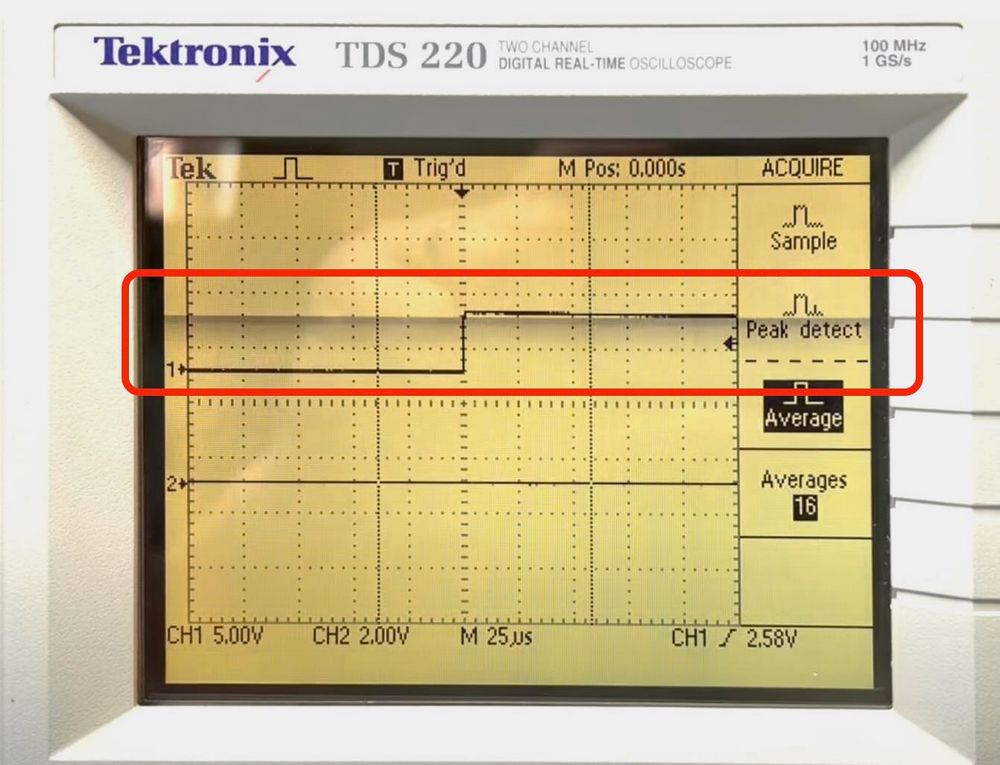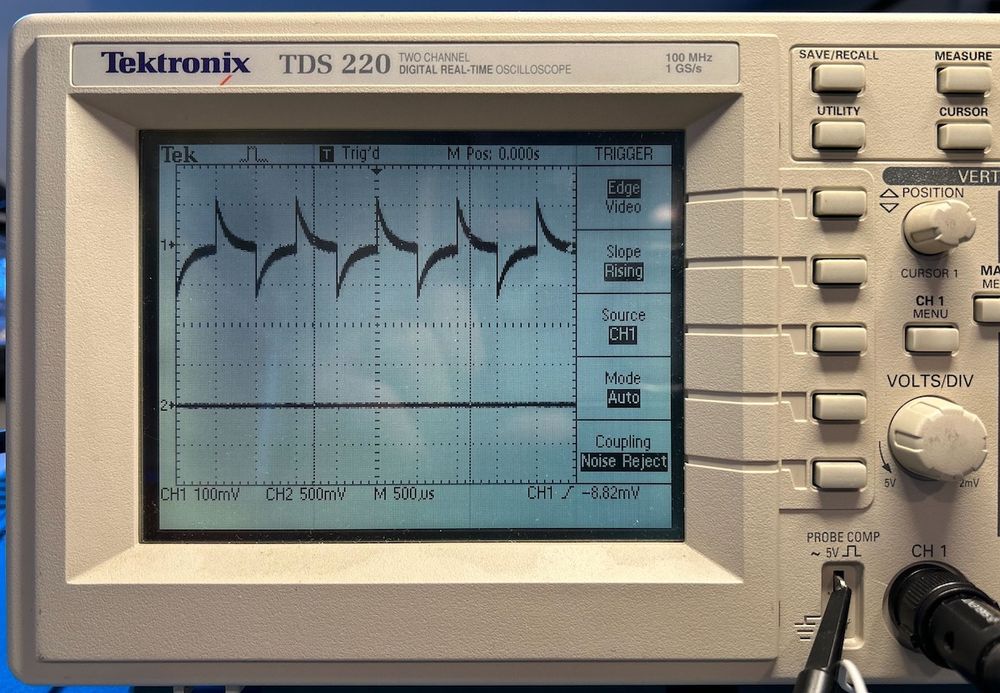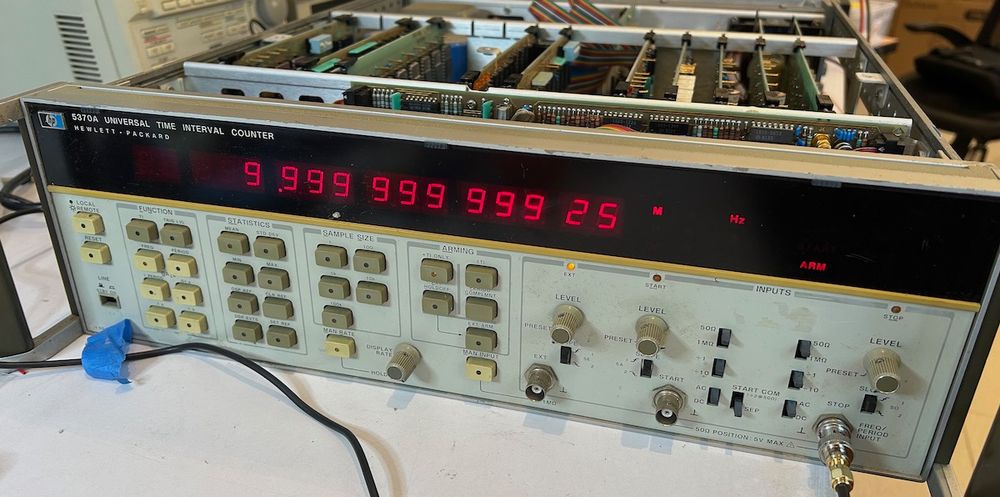Game Gear - TechWiki
Yes, they are! I had never seen these kind of caps before.
wiki.console5.com/wiki/Game_Gear
04.11.2025 13:53 — 👍 1 🔁 0 💬 1 📌 0

TDS220 screen showing horizontal band screen corruption

PCB inside LCD panel

TDS220 screen showing probe compensation waveform that's definitely not right.

TDS220 PSU PCB with arrows to places where there's fluid residue that shouldn't be there.
Fixing LCD Screen Corruption of a Tektronix TDS220 Oscilloscope (and other fixes)
tomverbeure.github.io/2025/11/03/T...
04.11.2025 07:14 — 👍 9 🔁 0 💬 1 📌 0
I didn’t know I needed this, and now I do.
02.11.2025 22:30 — 👍 1 🔁 0 💬 0 📌 0

Isotemp OXCO107-10 outside label

Inside of the OCXO, showing a Dewar flash and internal electronics.

Lab bench with oscilloscope, power supply, spectrum analyzer and OCXO

Spectrum with harmonics
Inside an Isotemp OCXO107-10 Oven Controlled Crystal Oscillator
tomverbeure.github.io/2025/10/26/I...
27.10.2025 05:08 — 👍 6 🔁 0 💬 0 📌 0
OTOH, I paid for the 16 channel MSO option on my scope, but I’ve never used it. The scope UI is just to terrible and slow compared to a Saleae or DSLogic SW.
22.10.2025 15:39 — 👍 0 🔁 0 💬 0 📌 0
The easy of sending data to your PC for decoding and the length of traces. I’ve used a USB logic analyzer to extract the full contents of a large SPI PROM, for example.
22.10.2025 15:36 — 👍 0 🔁 0 💬 0 📌 0
I had the 150-in-1. Spent a ton of time on it, but looking back, most of it was building stuff without having a clue about what I was doing. For some circuits, that would still be true today. :-)
20.10.2025 14:09 — 👍 2 🔁 0 💬 0 📌 0
Maybe I missed it in the (interesting!) article, but while it mentions radiation intensity, it doesn’t say how it compares to the actual radiation intensity in the LEO where the cubesat resides?
08.10.2025 16:01 — 👍 0 🔁 0 💬 1 📌 0

My new article on Harold Black and the invention of the Negative Feedback Amplifier has just been posted. I start the story with the invention of the telephone in the 1870s, to a patent lawsuit in the 1940s.
Check it out. Let me know what you think.
emedia.digikey.com/eMagazine-Vo...
06.10.2025 16:10 — 👍 6 🔁 2 💬 2 📌 0
The article is excellent!
06.10.2025 17:01 — 👍 1 🔁 1 💬 1 📌 0
The longevity of the Cyclone II EP2C5 is amazing. 21 years after introduction, it’s still the FPGA that I use most for hobby projects.
05.10.2025 19:32 — 👍 2 🔁 0 💬 0 📌 0

Based on the Unix versions available on tuhs.org, all of this appears to
have been introduced in 4.1c BSD. This is the version that adds
IPPORT_RESERVED to netinet/in.h and has the TCP/UDP port binding
code check it in in_pcbbind in netinet/in pcb.c. In case you think the
BSD people thought that this was an elegant idea, let me show you the
code:
if (lport) {
u_short aport = htons (lport) ;
int wild = 0;
/* GROSS */
if (aport < IPPORT_RESERVED && u.u_uid != 0) return (EACCES) ;
[...1
The BSD people knew this was a hack; they just did it anyway,
probably because it was a very handy hack in their trusted local
network environment. Unix has quietly inherited it ever since.
I'm writing about self-hosting and got wondering why ports <1024 are privileged on Linux, and require you to be root to bind to them.
Found this explanation and couldn't help but laugh. I'd always thought it was a bit of a hack.
utcc.utoronto.ca/~cks/space/b...
01.10.2025 09:53 — 👍 54 🔁 5 💬 3 📌 0
Want easy capsense touchpad buttons? Just a PCB & 4 resistors. Coming soon to my Tindie store! If you want to make your own, files are here: github.com/todbot/touch...
This demo in CircuitPython but also works in Arduino w/ my TouchyTouch lib
#circuitpython #capsense #captouch #raspberrypipico
29.09.2025 23:10 — 👍 20 🔁 2 💬 1 📌 0
Yeah, if that’s all you’re pulling it should be totally fine.
29.09.2025 22:46 — 👍 1 🔁 0 💬 0 📌 0
The 7805 is a linear voltage regulator. Its power consumption will be the current through it times the voltage drop. You have a pretty large drop of 14V, so the heat produced in the regulator could be significant. Something to keep in mind.
29.09.2025 21:25 — 👍 1 🔁 0 💬 2 📌 0
Cecilia Payne-Gaposchkin ✨ figured out what stars are made of ✨ when she was just 25. 🔭🧪
Her PhD thesis basically established the Harvard astro department — at a time when Harvard didn't officially allow woman students.
I wrote this little profile to mark the 100th anniversary of her thesis:
24.09.2025 09:14 — 👍 1880 🔁 869 💬 21 📌 36
My projects that require custom PCBs are on hold. 🥺
22.08.2025 16:19 — 👍 1 🔁 0 💬 1 📌 0

SR620 with analog oscilloscope on top of it

SR620 with front panel removed
Power Switch and Battery Replacement of an SR620 Universal Time Interval Counter
tomverbeure.github.io/2025/08/19/S...
20.08.2025 07:21 — 👍 6 🔁 0 💬 0 📌 0
“… and a baby alligator.” Because of course.
14.08.2025 01:19 — 👍 1 🔁 0 💬 0 📌 0
This is one of the most beautiful things I have witnessed, the craft here is impeccable.
13.08.2025 06:06 — 👍 19020 🔁 7400 💬 393 📌 992

"Application of AI for modelling and structural analysis of a parametric 2D frame with voice assistant"
This has nothing to do with anastruct either.
My only explanation is that the authors used AI to hallucinate a whole bunch of BS.
I want my money back!
13.08.2025 17:08 — 👍 5 🔁 0 💬 0 📌 0

Abstract of the paper

My name highlighted in a paragraph that lists as developer of the "anastruct" open source Python library.
The paper is behind a paywall. But since the suspense was killing me, I bought the paper. There it in a black an white: "[anastruct] was developed by Tom Verbeure with the aim of making structural analysis available, ..."
I'm flattered!
It uses [16] as reference. Let's check that out...
13.08.2025 17:08 — 👍 1 🔁 0 💬 1 📌 0

Screenshot of a google search that says: "Wiley Online Library
Python‐Powered Structural Analysis: Modeling and ...
3 days ago — It was developed by Tom Verbeure with the aim of making structural analysis available, insightful, and efficient for students, educators, and professionals."
I think AI hallucinated me into a paper about Modelling and Solving 2D Truss System! Something I know nothing about.
A few days ago, I submitted a blog post to Hackaday. Today I googled my name to see if it had been picked up. Instead it found this weird hit.
onlinelibrary.wiley.com/doi/10.1002/...
13.08.2025 17:08 — 👍 5 🔁 0 💬 1 📌 1
Not very typical, I hope?
12.08.2025 15:35 — 👍 1 🔁 0 💬 1 📌 0

Search traffic to video timings calculator. A red arrow points to the drop in traffic around Lunar New Year.
The Video Timings Calculator is my most popular webpage in Google Search by far, with most of clicks coming from Taiwan. Those are engineers working on monitors, TVs, laptops etc.
Traffic drops on Friday morning and ramps back up Sunday afternoon. It also drops the week of Lunar New Year.
12.08.2025 06:04 — 👍 9 🔁 0 💬 0 📌 0

Drop-down with 16K, 12K and 10K resolutions

HDMI 2.2 link rates

URL with video timings settings
3 new features for my Video Timings Calculator:
1. 10K, 12K and 16K resolutions added.
2. HDMI 2.2 96/80/64 Gbps data rates added.
3. You can share timings by copy and pasting the URL. Thanks SnowSquire@github!
Check it out here: tomverbeure.github.io/video_timing...
12.08.2025 05:48 — 👍 9 🔁 2 💬 1 📌 0
I have a 5359A, but other than creating short pulses, I don’t really know what to do with. The 5370A and the 5359A use the same chassis, power supply, reference clock board and CPU system. I believe they even share the dual vernier circuit to get below 5ns precision.
11.08.2025 05:58 — 👍 3 🔁 0 💬 1 📌 0

HP 5335A on top an HP 8656A on top on an HP 5370A.
Me too! 😀
The electronics flea market is a wonderful thing.
10.08.2025 23:08 — 👍 3 🔁 0 💬 1 📌 0

HP 5370A with open top showing a frequency of 9,999,999.999,25 MHz

Internals of the HP 5370A seen from the top

Annotated schematic of the HP 5370A reference clock buffer

Workbench showing the reference clock bench PCB with probes, oscilloscope and laptop
Repairing an HP 5370A Time Interval Counter
tomverbeure.github.io/2025/08/10/H...
10.08.2025 20:55 — 👍 22 🔁 0 💬 1 📌 0
I find it amazing that this scope was last calibrated in 2023. (Could also be 1923, but I don’t think so. 🙂)
04.08.2025 02:47 — 👍 1 🔁 0 💬 0 📌 0
logic synthesis abyss domain expert - frangible lut slut - caprotti valve gear and kylchap exhaust enjoyer - gives people tail dysphoria - aromantic […]
🌉 bridged from ⁂ https://fieldprogrammable.gay/@lofty, follow @ap.brid.gy to interact
Baochip makes open-source hardware.
Open silicon professional, FPGAs, ASICs, & more!
me@mith.ro
https://bit.ly/mithro-resume
https://linkedin.com/in/mithro
Electronics, maker, builder, engineer, ham radio (PD4MP), cnc, software development
https://nickstick.nl
reverse engineering, cryptography, exploits, hardware, file formats, and generally giving computers a hard time
Fedi: @retr0id@retr0.id
Macroblog: https://www.da.vidbuchanan.co.uk/blog/
Tinkerer Maker Solderer Mom • lateral thinker • LEDs improve everything
[bridged from https://mastodon.social/@geekmomprojects on the fediverse by https://fed.brid.gy/ ]
Autonomous Carbon Based LLM with 42 years of tuning on Information Attack and Defense.
Host of CanSecWest, and PacSec.
Security audits, code, IR, LLM, red team consulting.
Specialize in Firmware, and RF.
VA7MOV
She/They | 🏳️⚧️ Software Engineer | Building various audio and music devices
Website: https://northernpaws.io
Patreon: https://www.patreon.com/c/Northernpaws
GitHub: https://github.com/northernpaws
come see me bap at projects with varying success
Gfx coder and chip designer. He/him/3Dlabs/Muckyfoot/RAD/Valve/Oculus/Intel/Rec Room.
mastodon.gamedev.place/web/@TomF
(twitter.com/tom_forsyth if you're nasty)
Self taught maker just trying to make and learn more.
LEDs and Game Boys.
and a bit of gaming ofc
she/her
https://links.nataliethenerd.com/
Passionate about everything related to electronics and robotics.
Electronics freelancer when the sun rises and hobbyist when the sun falls.
I want you to win and be happy. Code, OSS, STEM, Beyoncé, T1D, open source artificial pancreases, Portland, 3D printing, sponsorship http://hanselminutes.com inclusive tech podcast! VP of Developer Community @ Microsoft 🌮
http://hanselman.com/about
Person who does electrical, computer, and music things.
Certified Machine Pervert with compiler-induced psychosis.
Robotanist
they/it/she
Maker of things and solver of problems. Huge nerd, cosplay lover, and nonbinary human. They/them
https://katzcreates.com/
Math & Art Videos.
* https://youtube.com/Inigo_Quilez
* https://iquilezles.org
Created Shadertoy, Pixar's Wondermoss, Quill, and more.
GPUs from fs to ms @ AMD / Interests: GFX, AI, RTL / Prev: AuthenTec (Digital HW), NASA, GaTech Grad, F1 fan. Views & statements are 100% mine.
Retired controls/software/firmware/security engineer. Been a long strange road from TTY repair to OSCP. #MKE.
Makers of HackRF One, Cynthion, YARD Stick One, and more. We design open source tools for innovative people.
LED artist & founder of Enlighted Designs Inc. Creator of elevated mood lighting and brilliant show-stopping apparel.


























